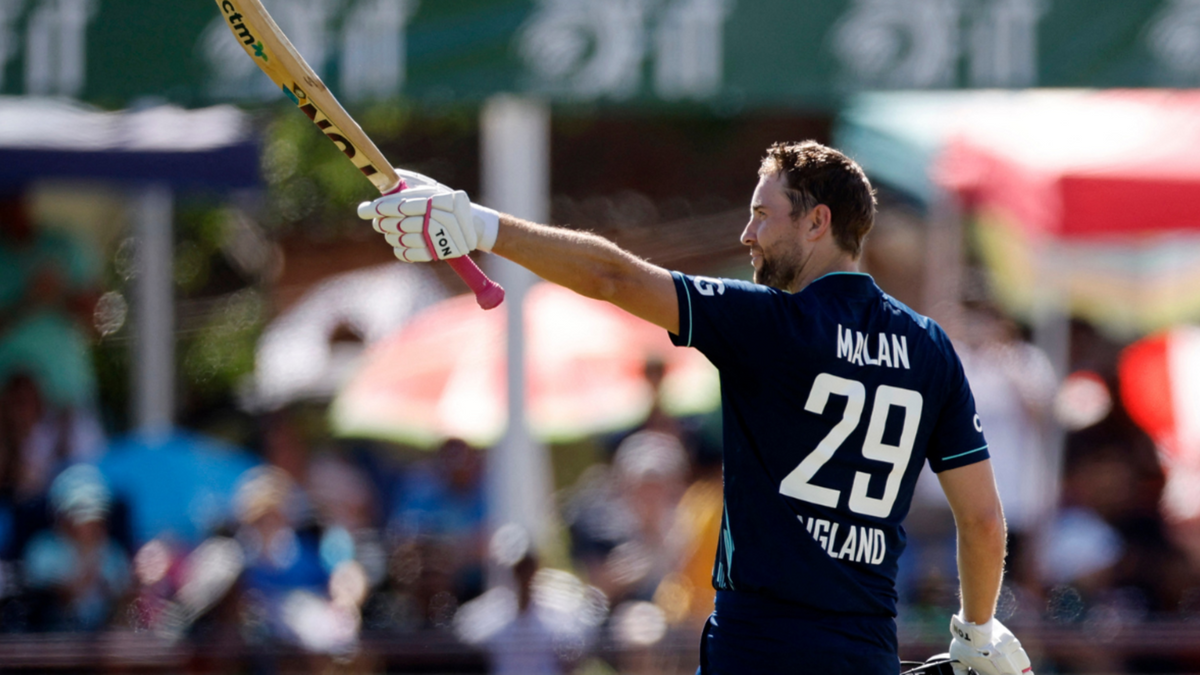
Dawid Malan’s ODI form over the last few years has been exceptional, but his place in England’s best XI is still at the mercy of the form and fitness of others, writes Katya Witney.
Dawid Malan’s century in the third ODI against South Africa was arguably his best in an England shirt. Against one of the best pace attacks in the world right now, Malan was 17 off 45 balls at the start of the 19th over. Jason Roy, Ben Duckett and Harry Brook – three players who Malan is in competition with if he is to be included in England’s World Cup squad – had all fallen within the first six overs. At the other end, Jos Buttler had rapidly overtaken his score and was on 30 off 48 balls.
By his own admission at the interval, Malan was struggling to get it off the square and was becoming visibly more frustrated with every dot ball. England had already registered their second-lowest ODI powerplay score since 2006 (20-3). However, having survived the examination by South Africa’s opening quick bowlers and with Aiden Markram into the attack, Malan found his first boundary. That reverse sweep seemed to break the shackles, and a front-foot drive in the following over brought up his second.
Just 58 balls later, Malan brought up his third ODI century. All of them have been scored within the last eight months. Whereas the first of the previous two came on a flat deck against the Netherlands, the second was a similarly outstanding knock against Australia, again helping to stave off a collapse. In Kimberley, Malan showed the full range of his abilities in the fifty-over format. He matched Buttler blow for blow in the middle overs, and their partnership completely changed the trajectory of England’s innings.
Over the last 12 months, Malan has averaged 60.75 in ODI cricket – only Buttler betters him in that regard. Since the 2019 World Cup he has the highest average (56.36) of any England player who has batted in at least ten innings. He is the only England player to average more than fifty and has scored the most hundreds of any England batter. But despite these stats, he has played less than half of England’s ODI matches in that timeframe. This has mainly not been through issues of scheduling or injury, as with England’s top-brass ODI names. The issue Malan faces is not a lack of form or ability but simply that he is usually the least preferred option, only serving as a fill-in when someone is absent. And, harsh as it is, that may well continue.
Joe Root should and will oust Malan from contention in a straight shootout between the two. Up until England’s two most recent ODI series, Malan mainly batted at three, rather than as an opener as he has throughout the last year – a position in which he averages 73.75 and strikes at over 100. But as Malan’s form became more difficult to ignore or leave out once Root returns, England found another way to include Malan in their ODI XI.
Malan has taken full advantage of the injury that has kept Jonny Bairstow of the picture for so long during the build-up to the World Cup. He has taken the opportunity to outperform Roy alongside him. But if Bairstow’s leg recovers before the World Cup, he will come back into the side, and Roy, as one of England’s greatest ODI batters, is ahead of Malan in the queue.
All Malan can do is continue performing as he has been and hope a spot opens up if Roy’s form continues to become a problem. While Roy has bought himself some breathing space with his century in South Africa, the two low scores he registered in the matches that followed did little to alleviate concerns about his consistency of late. Since 2019, Roy has averaged 29.40 compared to Malan’s 56.36, with both scoring their runs at similar rates (Roy 99.86, Malan 98.41). But Roy has played 29 matches to Malan’s 14 and only now, given his form has still not recovered with the World Cup bearing down, are there suggestions that Malan should get the nod over him.
Roy’s ODI record should not be disputed. He is a genuine England great in the format and formed one of the all-time great ODI opening partnerships with Bairstow. In terms of form over the last couple of years, Malan comes out on top. But in terms of overall pedigree, England see Roy as their premier option.
If Roy performs well in the upcoming tour of Bangladesh, or in the matches that follow later in the year, he will almost certainly retain his position. The only other slot Malan could possibly occupy in that scenario is at No.4. Brook’s swaggering 80 in the second ODI gave a glimpse of the possibilities he offers in that position, but a duck in the first and a six in the final game mean he hasn’t nailed down his spot yet. If Bairstow regains full fitness and Roy and Brook both excel, then Malan will find himself left out once more.
Nothing about Malan’s form or record indicates that he shouldn’t find a place in England’s best ODI XI. But, once again in his career, he is up against the form and fitness of others to keep his spot. All he can do is keep churning out runs and keep himself at the head of the queue.








